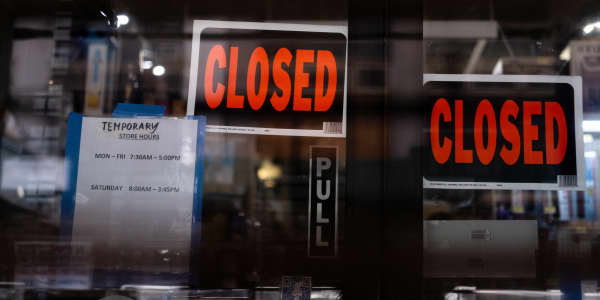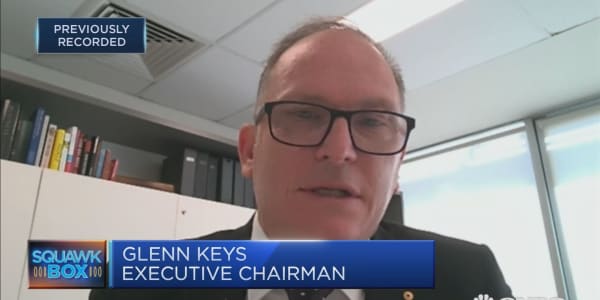
U.S. CEO confidence in the economy ticked up in the first quarter, the first time it has done so in more than a year. But it moved up by the smallest of margins, and for the third consecutive quarter, U.S. CEOs overall evinced even less economic confidence than business leaders in the beleaguered euro zone.
There was a small increase of 0.5 points in economic confidence among U.S. CEOs, and that allowed the United States to halt what had been a streak of four straights quarters of declining confidence, according to the latest YPO Global Pulse Index from the Young Presidents' Organization. But the only developed nation regions that remain below the United States in confidence level are the commodities-powered countries of Canada and Australia, according to the quarterly YPO survey of 24,000 CEOs based in 130 countries.
The small increase in confidence among U.S. business leaders mirrored CEO sentiment around the globe: Overall, the YPO Global Pulse Index rose 0.3 points from 58.0 in the fourth quarter of 2015 to 58.3 in the first quarter of 2016. A reading above 50.0 indicates expansion. However, two of three key investment metrics were on the decline. Global sales confidence registered a 0.2 point increase during the first quarter, but fixed investment and employee count registered declines of 1.5 and 0.6, respectively.
While overall economic confidence readings from Canada and Australia remain among the developed world's lowest, oil-exporting nations were some of the largest contributors to increases in the YPO Global Pulse Index in the first quarter, including Africa (+2.2) and Canada (+1.5). Along with the non-EU European region (+4.0), these were the only three regions to register quarter-over-quarter changes greater than or equal to 1.5.
Oil was yet again the poster child for volatility during the quarter. WTI started the quarter at $37.04/barrel, reached a low of $26 a barrel on February 11, a high of $41 on March 22 and ultimately settled at $38.34/barrel on March 31.
Not surprisingly, this same level of volatility was felt throughout capital markets, with most equity markets entering correction territory (defined as a decline of 10 percent or more) before rebounding in the second half of the quarter. The price of oil was a significant contributor to market and CEO confidence during the quarter. WTI rebounded 47 percent from its low as a result of declining production and inventory data in the United States. The number of U.S. rigs in operation has declined by 77 percent from October 2014.
Of the five participating countries that exported the most crude oil in dollar terms in 2015, four of them reported higher confidence readings during the quarter: Saudi Arabia (+14.1), Russia (+0.2), Canada (+1.5) and Nigeria (+8.9).
The Federal Reserve inaction on rates and Fed Chair Janet Yellen's remarks also contributed to the rally in capital markets during the second half of the first quarter. Contrary to prior statements that indicated the potential for three to four rate moves in 2016, the Fed opted not to raise rates in March and even indicated that rates would likely increase only twice in 2016, given recent "global economic and financial developments."
These comments, and others that followed, indicated a more dovish positioning by the Fed and the potential for rates to remain lower for an extended period of time. The increased focus on "global" events within the Fed minutes indicates an appreciation for the strength of the dollar relative to other currencies across the globe. Nevertheless, during the quarter, the trade-weighted dollar index declined by more than 4 percent. A weaker dollar is generally good for exports. The aforementioned factors contributed to CEO's evaluations of economic conditions as 33 percent of respondents thought the economy had improved during the past six months (versus only 28 percent feeling the same way in January).
With GDP growth in China continuing to slow, the rest of the world is feeling the pain. The IMF revised its global GDP forecast down yet again to 3.2 percent. With the second-largest economy in the world continuing to slow and muted global growth expectations for other developed economies, it is not surprising that CEOs remain reluctant to invest significantly in their businesses.
Despite a confidence reading well above contraction levels, the quarter-over-quarter decline in fixed investment, from 59.2 to 57.8, is worrisome as the trend continues to be to the downside with last quarter's reading representing the sixth decline in the last seven quarters.
The slowdown in China, and many of the commodity exporting countries that it supports, contributed to a 4 percent decline in exports in the United States in 2015. China was also on the minds of investors at the beginning of the year, with sentiment remaining rather bleak. Despite some speculation that previously reported GDP numbers were artificially high, GDP growth for China came in at 6.7 percent, which was higher than many had expected.
Further discussion of currency devaluation also contributed to a reversal in the negative sentiment for the country as a weaker currency would lead to improved global demand and potentially stronger growth. Confidence in China rose 1.9 points for the quarter across participating CEOs, despite the concerns at the start of the year.
— By Christopher Moore, managing partner and chief investment officer, Massey Quick
About YPO
CNBC and YPO (Young Presidents' Organization) have formed an exclusive editorial partnership consisting of regional "Chief Executive Networks" in the Americas, EMEA and Asia-Pacific. These Chief Executives Networks are made up of a sample of YPO's global network of 23,000 top executives from 120 countries who are on the front lines of the economy and run companies that collectively generate $6 trillion in annual revenues.






